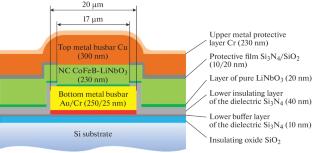基于硅 MOSFET 和纳米复合 Memristors 的 2T1R 结构电阻式存储器
IF 0.8
Q3 Engineering
引用次数: 0
摘要
利用硅 MOSFET(金属氧化物半导体场效应晶体管)和基于 CoFeB-LiNbO3 纳米复合材料薄层和 a-LiNbO3 薄层的忆阻器横杆,开发了一种 2T1R 结构受控存储器的制造序列。研究表明,当在忆阻器中使用铜顶电极时,可以获得相对较小的电阻开关电压和电流(2.5 V 和 0.4 mA),适合在 MPW 技术服务 (https://mpw.miet.ru/) 范围内创建内存微芯片。本文章由计算机程序翻译,如有差异,请以英文原文为准。

Resistive Memory in 2T1R Architecture Based on Si MOSFETs and Nanocomposite Memristors
A manufacturing sequence for the formation of controlled memory in the 2T1R architecture using Si MOSFETs (metal-oxide-semiconductor field-effect transistor) and memristor crossbars based on thin layers of CoFeB-LiNbO3 nanocomposite and a-LiNbO3 is developed. It is shown that when using Cu top electrodes in memristors, relatively small resistive-switching voltages and currents (2.5 V and 0.4 mA) are achieved, which are suitable for creating a memory microchip within the MPW technology service (https://mpw.miet.ru/).
求助全文
通过发布文献求助,成功后即可免费获取论文全文。
去求助
来源期刊

Nanotechnologies in Russia
NANOSCIENCE & NANOTECHNOLOGY-
CiteScore
1.20
自引率
0.00%
发文量
0
期刊介绍:
Nanobiotechnology Reports publishes interdisciplinary research articles on fundamental aspects of the structure and properties of nanoscale objects and nanomaterials, polymeric and bioorganic molecules, and supramolecular and biohybrid complexes, as well as articles that discuss technologies for their preparation and processing, and practical implementation of products, devices, and nature-like systems based on them. The journal publishes original articles and reviews that meet the highest scientific quality standards in the following areas of science and technology studies: self-organizing structures and nanoassemblies; nanostructures, including nanotubes; functional and structural nanomaterials; polymeric, bioorganic, and hybrid nanomaterials; devices and products based on nanomaterials and nanotechnology; nanobiology and genetics, and omics technologies; nanobiomedicine and nanopharmaceutics; nanoelectronics and neuromorphic computing systems; neurocognitive systems and technologies; nanophotonics; natural science methods in a study of cultural heritage items; metrology, standardization, and monitoring in nanotechnology.
 求助内容:
求助内容: 应助结果提醒方式:
应助结果提醒方式:


